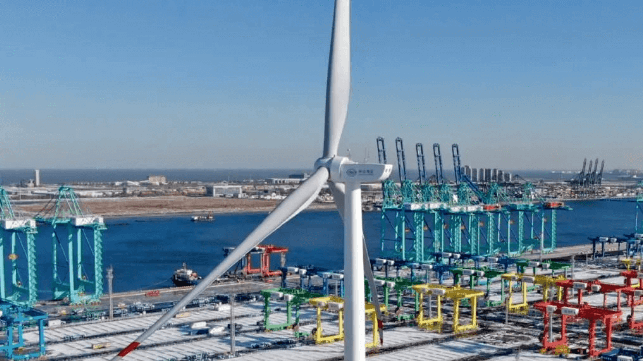COSCO Launches Zero Emissions Terminal in Tianjin Port Expansion

COSCO Shipping Ports, China’s large global port operator, highlighted the launch of its new zero-carbon terminal at the northern port of Tianjin. According to the port company, the terminal became self-sufficient using clean energy for its operations. It is part of the company’s overall effort to expand operations at Tianjin.
On December 15, what COSCO is calling the world’s first smart green energy system for the zero-carbon terminal was successfully connected to the power grid at the Second Container Terminal of Tianjin Port. Compared with traditional terminals, COSCO highlighted that the “zero-carbon” terminal is powered by wind and solar (photovoltaic) energy, achieving zero carbon emission in energy consumption and production. It becomes self-sufficient in the operations of the smart container terminal at Section C of Tianjin Port.
Phase I of Tianjin Port Section C Terminal Smart Green Energy System Project includes two 4.5MW distributed wind turbines, which are expected to generate 23.3 million kWh of electricity annually and reduce the carbon emission by 20,600 tons per year. In addition, the 1.4MW PV project under construction is expected to be connected to the grid in mid-January 2022.
COSCO said it will also use both wind and solar power during the project’s Phase II construction.
Tianjin is one of the world’s ten largest container ports and China’s northern most port. In 2020, Tianjin grew volumes by more than five percent handling 18.5 million TEU. COSCO Shipping Ports, which operates and manages 370 berths at 37 ports worldwide and a combined annual handling capacity of 124 million TEU, has been pursuing a strategy to further develop the port of Tianjin. Located near Beijing, the company says the port has a strategic advantage with access to the northern industrial corridor.
Last month, COSCO Shipping Ports Limited and China Shipping Terminal Development Co. signed a new agreement for the ownership of the Tianjin Container Terminal, one of four primary container terminals in the port complex. COSCO said it expects to fully facilitate the development of TCT as an international shipping hub in Northern China. This is to be done by optimizing the operational efficiency of the shipping lines calling at the terminal and promoting the synergy of the hub-and-spoke and transshipment network in the Bohai Rim region. They have already entered into several new agreements with industrial shippers to use the port facilities.
